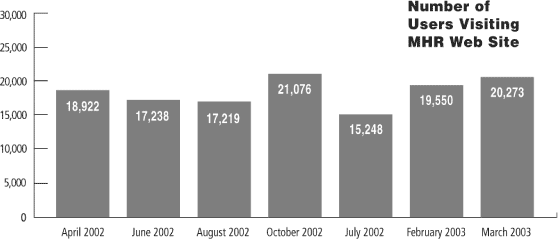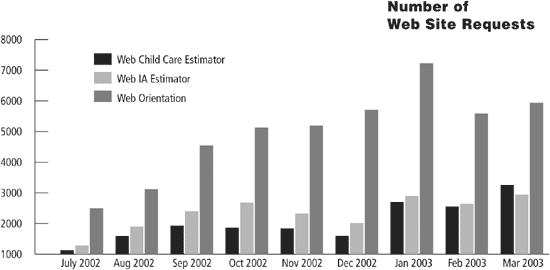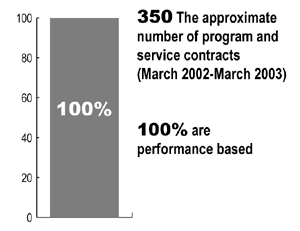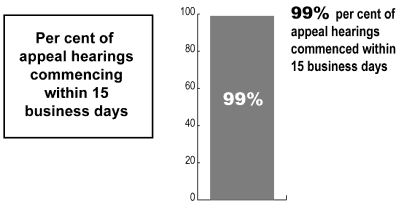Performance Reporting — Continued
Goal 4: The Ministry is an Accountable Organization
Objective
Service delivery is streamlined to improve efficiency |
Strategy
Use technology to increase client access to information |
Measure 4.1: Number of times ministry web site is accessed.
Number of calls, contacts across the other service delivery channels.
Results


| 2002/03 Target |
Results |
| Complete feasibility design for electronic
service delivery by end of 02/03 |
Feasibility study to expand client access
to services complete. Three web-based services implemented:
1. income assistance estimator
2. child-care subsidy estimator
3. web-based orientation for clients.
|
Description
This measure assesses the degree to which
people have access to ministry information and services electronically.
Use of the ministry web site is expected to increase as more British
Columbians become computer literate and gain access to the internet.
The ministry has recognized that it is important
to increase its use of technology, for improvement of the ministry's
business processes, and for the benefit of ministry clients. A
proxy measure (number of visits to the ministry web site) was
included in the 2002/03 service plan as a way to highlight the
importance of electronic service delivery.
During 2002/03, the ministry expanded its use
of information technology to include an income assistance estimator
for people to assess their eligibility for income assistance,
a child-care subsidy estimator for parents to assess their eligibility
for a subsidy, a web-based orientation for clients, and e-learning
services for staff. These tools are part of the ministry's effort
to use technology to increase choices for clients and the public,
and provide them with information to better enable them to exercise
personal responsibility.
As the chart above indicates, the web-based
orientation was used between 2,494 and 7,228 times each month
during 2002/03, the child care subsidy estimator was used between
1,132 and 3,255 times per month, and the income assistance estimator
was used between 1,282 and 2,935 times per month.
This measure is not included in the 2003/04
service plan. It measures outputs, rather than outcomes, and the
ministry is striving to increase the number of performance measures
that are outcome-oriented.
Data Reliability and Assumptions
Source: Ministry database.
Reliability: High. However, the number of web site visits can
be misleading and does not necessarily reflect the number of users.
The number of requests is defined as the number of files opened
per visit.
Objective
Ministry contracts are performance-based |
Strategy
Develop performance-based contracts for programs and
services |

Measure 4.2: Number of performance-based contracts with service
providers, and proportion of program and service contracts that
are performance-based
Results

| 2002/03 Target |
Results |
| The majority of contracts are performance-based
by 2003/04 |
100% |
Description
A performance-based contract links payments with the achievement
or completion of a pre-determined deliverable. The deliverable
must be measurable in order to evaluate the contractor's performance.
Deliverables can be outputs (such as job descriptions, software
packages, beds used in a hostel/shelter) or outcomes (such as
employment program clients remaining independent of income assistance).
The service plan set out a target of a majority of contracts
being performance-based, to be achieved by 2003/04. In 2002/03,
this target was more than achieved, with 100 per cent of contracts
being performance-based.
Why This Measure is Important
This measure helps to assess the ministry's progress in becoming
more accountable for results. Performance-based contracts ensure
a high level of service quality, as well as cost-effective use
of ministry resources. Payments to contracted service providers
are tied directly to the results they achieve.
The ministry will continue to monitor this measure in its next
service plan. Future refinements may include distinguishing contracts
that link payments to outcomes from those linking payments to
outputs.
Data Reliability and Assumptions
Source: Ministry's records.
Reliability: High.
Objective
Accountability units are assigned across the ministry
|
Strategy
Implement a ministry-wide performance management system
with assigned accountability |
Measure 4.3: Quarterly performance management reports and
proportion of performance targets met
Results
Four quarterly performance reports were submitted to Treasury
Board, reporting actual as compared to forecast financial and
caseload information. Monthly caseload monitoring information
was published.
The 2002/03 ministry service plan contained four performance
targets. Three of these targets were met; program changes made
the fourth target unnecessary and no longer relevant to ministry
operations (see measure 1.1 for more information).
| 2002/03 Target |
Results |
| Establish baseline for ministry-wide performance
management |
Baseline established:
Quarterly performance reports completed
|
Description
This measure was intended to assess progress toward the implementation
of a ministry-wide performance management system with assigned
accountability. The measure included in the 2002/03 service plan
is a proxy measure that highlights the importance of performance
management.
Becoming a performance-based organization involves a shift in
culture. To support this shift, the ministry has taken steps to
identify accountabilities and monitor performance. Regional Executive
Officers have signed accountability agreements that establish
priorities for the year. In 2003/04, managers will sign Employee
Performance and Development Plans that outline their priorities
for the coming fiscal year. The ministry will continue to find
ways to improve and refine its performance management system.
This measure is not included in the 2003/04 service plan. It
measures outputs rather than outcomes and the ministry is striving
to increase the number of performance measures that are outcome-oriented.
Data Reliability and Assumptions
Source: Ministry's records.
Reliability: High.
Objective
Individuals have access to an impartial and responsive
appeal system |
Strategy
Implement a regionally-based tribunal appeal system for
BC Employment and Assistance Clients |

Measure 4.4: Average time taken to adjudicate appeals
Results
Between 1999 and 2002, adjudication of appeals took an average
of 22 weeks. Since the introduction of Employment and Assistance
Appeal Tribunals in September 2002, there was only one case where
a hearing did not begin within 15 business days. Under the new
appeal system, the majority of appeals can be adjudicated within
six to seven weeks.
| 2002/03 Target |
Results |
| Establish baseline for timeliness |
Appeal hearing to be commenced
within
15 days
Majority of appeals to be adjudicated within
6 to 7 weeks
|
Description
In September 2002, the ministry introduced the Employment and
Assistance Appeal Tribunal — a single, independent, streamlined
appeal system. Its mandate is to ensure an appeal process that
is open, fair and timely.
This measure helps to assess the efficiency of the ministry's
appeal process.
Why this Measure is Important
Timely appeals reduce uncertainty for clients and provide for
more efficient use of ministry resources in administering appeals.
Development of a streamlined appeal process was identified as
a key priority in the Premier's June 25, 2001 letter to the Minister
of Human Resources.
Improvements To Measure
The ministry has refined this measure to better reflect outcomes,
recognizing that average times could be significantly affected
by a small number of cases that take either a very long or very
short time to adjudicate.
New Measure (2003/04): Per cent of appeal hearings commenced
within 15 business days

| New Measure |
|
2002/03 |
2002/04 |
2002/05 |
2002/06 |
| Per cent of appeal
hearings commenced within 15 business days |
Targets |
Establish Baseline |
|
|
|
| Results |
99% |
|
|
|
The ministry has established a baseline of 99 per cent of appeal
hearings commencing within 15 business days.
Data Reliability and Assumptions
Source: Ministry's records.
Reliability: High.
